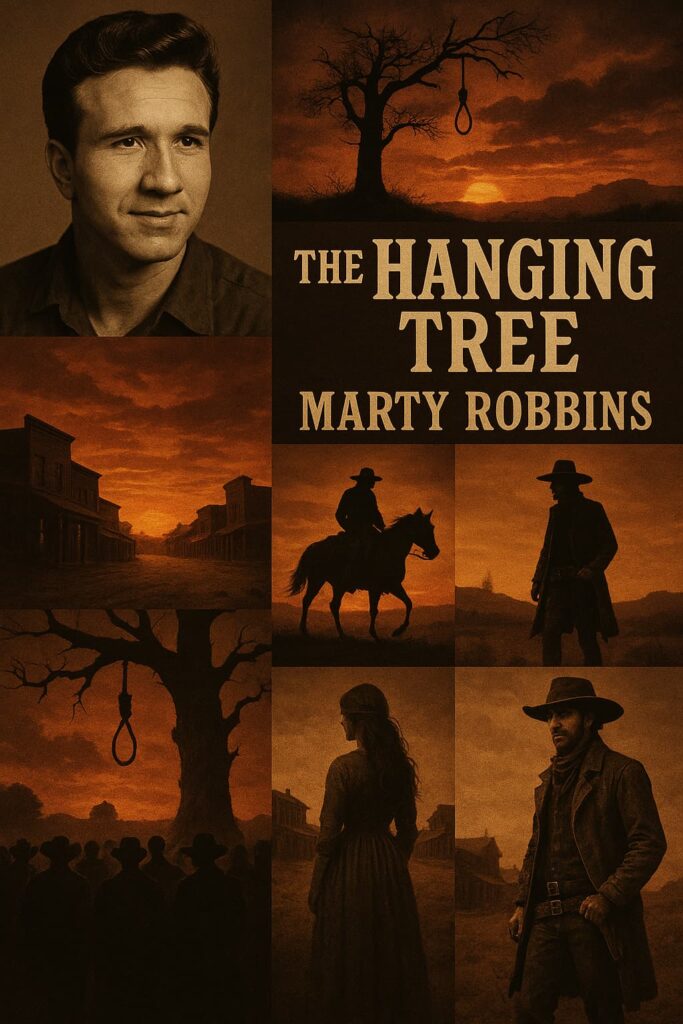
Where Shadows Linger: The Unforgettable Echo of “The Hanging Tree”
A ballad of lost love and hard-won redemption, sung against the stark backdrop of the American West.
Ah, to cast our minds back to 1959. The airwaves were alive with the sounds of a changing musical landscape, yet for those of us who cherished the timeless tales of the frontier, a voice emerged that spoke directly to the soul. It was the incomparable Marty Robbins, a man whose melodic storytelling could transport you instantly to dusty trails and lonely sunsets. And in that pivotal year, he released a song that wasn’t just a tune, but a vivid, aching painting of struggle and hope: “The Hanging Tree.”
This haunting ballad wasn’t merely a standalone single; it was the title song from the major Hollywood Western film of the same name, starring the iconic Gary Cooper and Maria Schell. Released by Columbia Records, Marty Robbins‘ rendition of “The Hanging Tree” resonated deeply with audiences, climbing the charts to a respectable position. It peaked at Number 15 on the Billboard Hot C&W Sides chart and also made an impact on the pop charts, reaching Number 38 on Billboard, Number 31 on Music Vendor, and Number 42 on Cash Box. While not perhaps his highest-charting hit, its cultural footprint, entwined with the film, made it utterly unforgettable. It even earned nominations for the Academy Award and the Golden Laurel Award for Best Song in 1960, a testament to its poignant lyrics and powerful melody, penned by Mack David and Jerry Livingston, with the film’s score by Max Steiner.
The story woven within “The Hanging Tree” is a narrative of profound emotional weight, mirroring the complex themes of the film it accompanied. It speaks of a man, lost and haunted by a past heartbreak, who arrives in a rough-and-tumble gold rush town. He carries with him not just the hope of striking gold, but a crushing memory – a love that “could never be.” The “hanging tree” in the song, initially, is a grim metaphor for where he has left his dreams, his very heart, due to this past wound. It symbolizes despair, a place where aspirations go to die, much like the outlaws met their end in those unforgiving times. “Go hang your dreams on the hangin’ tree / Your dreams of love that could never be,” the wind seems to whisper in his ears, a cruel echo of his own resignation.
But as the song unfolds, so too does a tale of unexpected connection and eventual rebirth. Despite his efforts to remain isolated, guarding his gold and his shattered heart, life, as it often does, intervenes. He finds another who loves him, a testament to the persistent human need for companionship and healing. The lyrics describe a man who faces threats to his newfound prosperity and, ultimately, to his very life, being brought to the physical hanging tree. Yet, in a powerful twist, this moment of near-death becomes a catalyst for profound change. “To really live you must almost die,” the song asserts, revealing that it is through this brush with oblivion, and the sacrifice of another, that he is finally set free. The gold that was once his obsession becomes secondary to the true riches of life and love. The “hanging tree,” once a symbol of his despair and emotional gallows, transforms into a “tree of life, new life for me / A tree of hope, new hope for me / A tree of love, new love for me.”
For many of us who remember those days, the song evokes a deep sense of connection to the rugged individualism and moral dilemmas of the Old West, but also to our own journeys through life’s triumphs and tribulations. We’ve all, in some form, had our own “hanging trees” – moments of despair, lost opportunities, or lingering regrets where we felt compelled to “hang” our dreams. But like the protagonist in Marty Robbins‘ heartfelt delivery, we’ve also perhaps found that salvation can come from unexpected places, that hope can blossom even in the darkest of shadows, and that true love has the power to redeem and renew.
Marty Robbins himself, with his smooth baritone and effortless command of a narrative, was the perfect conduit for such a story. He wasn’t just singing words; he was painting scenes, evoking emotions, and inviting listeners to reflect on their own lives. His career was built on these kinds of poignant, often cinematic, ballads that went beyond simple country music, crossing over into the broader American consciousness. “The Hanging Tree” stands as a magnificent example of his artistry, a timeless piece that continues to resonate, reminding us that even from the brink of despair, a new, vibrant life can emerge, carried forth by the enduring power of love and resilience. It’s a song that settles into your bones, a melody and a message that, once heard, is never truly forgotten.